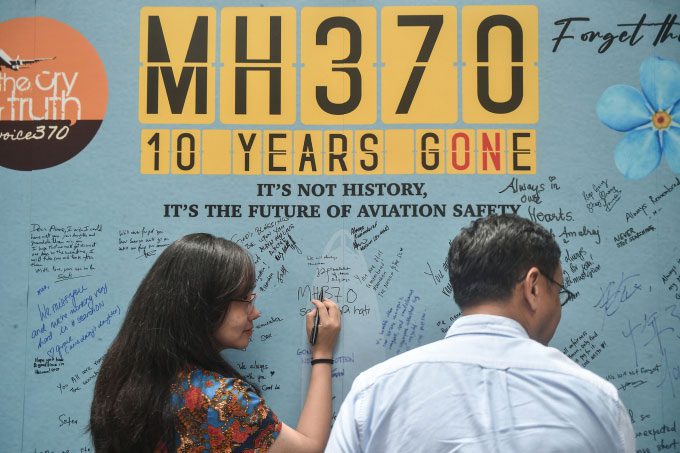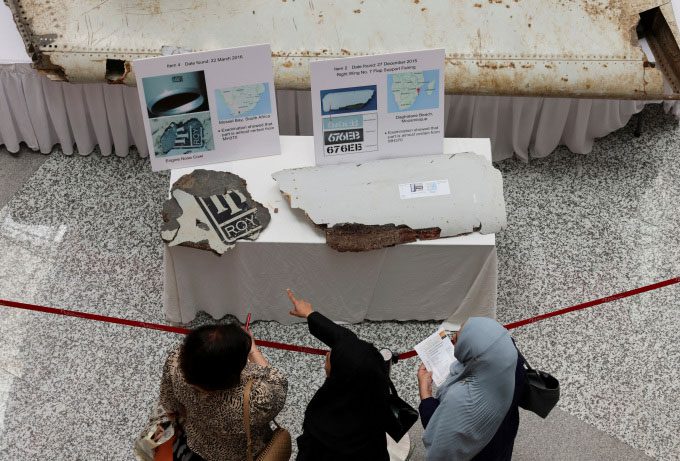Ten years have passed since the disappearance of MH370, and despite numerous search efforts and theories proposed, no one has been able to answer the question: Where is the plane?
Shortly after midnight on March 8, 2014, a Boeing 777 took off from Kuala Lumpur International Airport in Malaysia, gradually reaching a cruising altitude of 10,600 meters. After being instructed to switch radio frequencies by air traffic control, the pilot politely responded, a common courtesy in such exchanges: “Good night, this is Malaysia 370.” This was the last message transmitted from Malaysia Airlines flight MH370.
After the aircraft, carrying 239 people, deviated from its regular route to Beijing and vanished over the Indian Ocean, an extensive and costly multinational search operation was launched. However, ten years later, the biggest mystery in aviation remains unsolved.

Relatives of passengers on flight MH370 during a memorial event for the 10th anniversary of the plane’s disappearance at a shopping center in Subang Jaya, on the outskirts of Kuala Lumpur, Malaysia, on March 3. (Photo: AFP).
Radar data recorded by the Malaysian military indicated that as MH370 entered the Gulf of Thailand, it climbed to an altitude of 13,700 meters, exceeding the permissible flight ceiling, before abruptly changing direction westward due to the actions of someone in the cockpit.
The plane then descended to 7,000 meters, below the usual cruising altitude, as it approached Penang Island, one of Malaysia’s largest islands. There, officials believe the aircraft climbed again while changing course, flying northwest towards the Indian Ocean.
By March 24, 2014, based on the analysis of Inmarsat satellite signals, the Malaysian government declared that MH370 had flown thousands of kilometers off its planned route, heading south into the Indian Ocean. Its journey ended west of Perth, Australia, with no survivors on board.
However, KS Narendran cannot accept that his wife, Chandrika, has seemingly vanished into thin air. “I worry that if we do not know what happened to the flight, the tragedy will repeat itself,” he said.
How could a modern Boeing 777, equipped with sophisticated devices in the era of global satellite tracking and continuous communication, disappear without a trace? This question continues to haunt all those who fear flying, as well as ordinary people.
The journey and last communications of MH370. (Video: CNN).
“With each passing anniversary, my grief lessens, but the frustration of not having answers about what really happened to the flight grows,” Narendran said. “Knowing where the flight ended and what led to the accident, in any form, is still very important. That question occasionally pops into my head with a sense of confusion, even disappointment. Perhaps I will never know.”
The desire for answers also burns within the families of the pilots who operated that fateful flight, as countless accusations and conspiracy theories have emerged over the past decade.
The first phase of the search for the missing aircraft lasted 52 days and was mainly conducted from the air, with 334 flights scouring an area of over 4.4 million square kilometers. Various strategies and search areas were revised, but the multinational forces could not find any traces, even while deploying the most modern equipment.
In January 2017, the governments of Australia, Malaysia, and China decided to suspend the search operation after reviewing over 119,000 square kilometers of the Indian Ocean floor. This effort cost $150 million but yielded no results.
In January 2018, under pressure from the families of the passengers and crew members, the Malaysian government initiated another search in collaboration with Ocean Infinity, a U.S. company. After several months, the Ocean Infinity-led operation concluded without finding any evidence of the aircraft’s whereabouts.
Authorities have yet to locate the fuselage, but approximately 20 fragments believed to be from the aircraft have been discovered along the coastline of mainland Africa and on the islands of Madagascar, Mauritius, Réunion, and Rodrigues.
In the summer of 2015, investigators determined that a large object washed ashore on the French island of Réunion in the Indian Ocean was a part of a wing belonging to the Boeing 777, suggesting it could be debris from MH370.
Another triangular piece made of fiberglass and aluminum, bearing the words “No Step,” was found in February 2016 on a deserted beach along the coast of Mozambique.
Later, in September 2016, the Australian government confirmed that a wing fragment that washed ashore on the island of Tanzania, East Africa, belonged to flight MH370. The Australian Transport Safety Bureau matched its identification number with that of the missing Boeing 777.
A multitude of theories has been put forward regarding the reasons for the aircraft’s disappearance. The lack of information about what happened to the flight has led public opinion and investigators down various paths.
Some officials believe the plane ran out of fuel and the pilot attempted to make an emergency landing at sea. Others think the pilot deliberately crashed the plane into the ocean or that the aircraft was hijacked.
The theory that the pilot intentionally deviated from course gained traction after data recovered from the flight simulator at Captain Zaharie Ahmad Shah’s home indicated he had planned a flight path to the southern Indian Ocean.

An undated photo of Captain Zaharie Ahmad Shah. (Photo: Reuters).
Fuad Sharuji, who was the crisis management director of Malaysia Airlines at the time of MH370’s disappearance, noted that such theories have put the Zaharie family in distress. They have increasingly isolated themselves while grappling with the conspiracy theories surrounding him.
“Everything has been tough for them. They have stayed away from the media because they cannot accept the accusations… They are doing their best to continue with life,” Sharuji said.
Dr. Ghouse Mohd Noor, a friend of Captain Zaharie, stated that the pilot’s family still hopes for a day when answers will be found. “There is still no conclusion. There must be an explanation for what happened,” he said. “His wife and children are still waiting. The big question remains unanswered. Everyone needs a conclusion. I pray day and night that they will find the plane.”
Another hypothesis that aviation experts believe is more likely is that the pilots made a mistake rather than intentionally crashing the plane into the ocean. Zaharie may have encountered issues such as a fire or cabin depressurization and intended to return the aircraft to Malaysia, but lost consciousness due to smoke or lack of oxygen.
In the chaos, Zaharie or the co-pilot may have accidentally turned off the communications equipment. The aircraft then continued what is referred to as a “ghost flight,” where those on board had died, but the plane continued to fly on autopilot until it ran out of fuel.
After more than four years of search and investigation, a 495-page report released in 2018 provided no convincing answers regarding the aircraft’s fate.
Kok Soo Chon, the head of the investigation team, stated that current evidence, including the plane’s significant deviation from its original course and the transponder being turned off, indicated that “illegal intervention” had occurred. However, there was no evidence of who intervened or why.
The report also reviewed information about all passengers and crew members, including Captain Zaharie and First Officer Fariq Abdul Hamid, such as their financial status, health, radio voice, and even their demeanor when coming to work that day. No abnormalities were detected.
Now, a new search may be on the horizon.
Last week, Malaysian officials announced that the government is ready to discuss a new search campaign, as Ocean Infinity stated it has found “new evidence” regarding traces of MH370 based on more advanced technologies, although no details were provided.
“This search is considered the most challenging yet essential mission at present,” said Oliver Plunkett, CEO of Ocean Infinity. “We are working with many experts, some outside of Ocean Infinity, to continue analyzing data in hopes of narrowing the search area to a region with a higher likelihood of success.”
Sylvia Spruck Wrigley, author of three books on the disappearance of MH370, noted that while the incident may remain a mystery forever, the global aviation industry has learned a great deal from the tragedy and implemented new measures to ensure greater safety.

People view debris believed to be from MH370 at the 10th anniversary memorial event for the disappearance in Subang Jaya, Malaysia, on March 3. (Photo: Reuters).
Europe and the UK have mandated the installation of an additional low-frequency underwater locator beacon on aircraft, assisting search and rescue teams in locating survivors at sea. Attached to the aircraft fuselage, these beacons must be capable of transmitting signals for at least 90 days, three times longer than previous regulations. Additionally, cockpit voice recorders are now required to retain a minimum of 25 hours of data, instead of just two hours.
However, after 10 years of unanswered questions, theories continue to proliferate online to fill the information void. “It seems that people cannot imagine that we may never know what happened,” said Spruck Wrigley.


















































